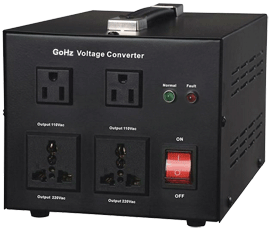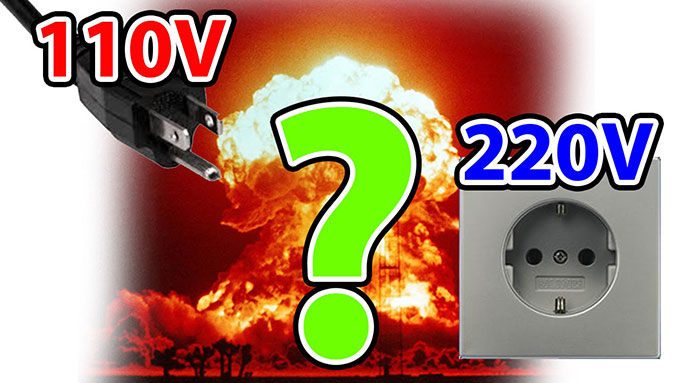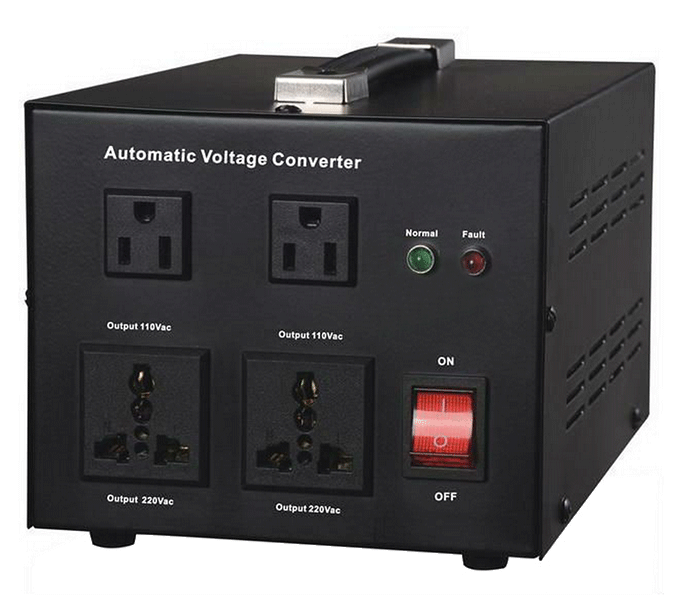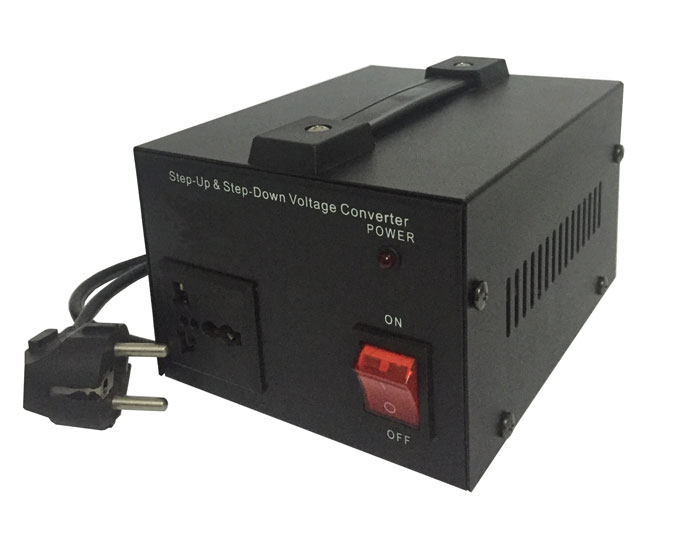How to Convert 120v to 240v? Voltage Converter Application
120V (110v) outlet can power virtually any standard device you can imagine, from tiny handheld electronics to large appliances. However, the item you want to use may require the higher 240V (220v, 230v) outlet. Fortunately, converting your outlet from 120V to 240V is a relatively simple project. Moreover, buying a reliable voltage converter will make the job even easier.
Gather Your Tools, and Turn Off the Power
The tools needed to convert an 120V wall outlet to a 240V outlet include screwdrivers, a neon voltage tester, and a black marker. You also need a 240V receptacle and a double-pole circuit breaker. Turn off the power at the main circuit breaker to avoid electrocution while you are working. Even with the power off, the terminals and wires on the main breaker carry an electrical charge, so you should never touch them for any reason.
Remove and Disconnect the Outlet Breaker and Wires
Locate the specific terminal that governs the 120v outlet, and loosen it with the screwdriver. Next, remove the wire connected to the terminal. Carefully pop the breaker off of the panel, and set it aside. Locate the neutral terminal by following the white wire, and loosen the screw. Pull the wire off the bus bar, and color the last few inches of the wire with your black marker. This makes the wire easier to identify and easier for our 120v to 240v converting job.
Install the Double-Pole Circuit Breaker
Hook the two tabs on the back of the 120v double-pole circuit breaker to the lock bar inside the breaker panel. Press the tabs firmly, and immediately switch the new breaker off. Locate the two terminal screws on the new breaker and loosen them. Slide the wire previously connected to the old breaker into one terminal and tighten it. This step must be done carefully, in order to achieve 120V transform to 240V.
Install the 240V Receptacle
Slide the prongs of the neon voltage tester into the existing socket to ensure it does not contain a current. If the lamp on the tester doesn't light up, you can proceed. Remove the screw holding the 120V outlet cover in place, and pop it off. Remove the screws holding the receptacle in place, and slide it out of the electrical box. Remove the white, black, and ground wires from the receptacle by loosening the screws on the corresponding terminals. Locate the green ground terminal on the new outlet, wrap the end of the ground wire in a clockwise U-shape around the screw, and tighten it firmly. After this step, we finally managed the operation of 120V to 240V converting.
Test the Device
Turn the power back on at the main service panel, slide the prongs of the neon voltage tester into the new socket, and test to ensure it is working. Additional lamps will light up to indicate the new, higher rating. Be sure that the new breaker only covers the new 240V outlet, since more coverage can cause electrical or operation problems with additional powered components. Now, you can safely use your appliance on the 120V to 240V power outlet.
Purchase a Step-up Voltage Converter for 120V to 240V Converting
Step-up voltage converter is widely applied to all types of imported 120V low-voltage electrical appliances, such as television, hair dryer, electric heater, rice cooker, induction cooker, coffee machine, battery charger, electric knife, fax machine, air conditioners and other equipment. Voltage converter can be used to convert voltages as long as power requirements are met. For example, you can change 120V (110v) to 240V (220v, 230v). Your electrical appliances can be used in your home assured.

Gather Your Tools, and Turn Off the Power
The tools needed to convert an 120V wall outlet to a 240V outlet include screwdrivers, a neon voltage tester, and a black marker. You also need a 240V receptacle and a double-pole circuit breaker. Turn off the power at the main circuit breaker to avoid electrocution while you are working. Even with the power off, the terminals and wires on the main breaker carry an electrical charge, so you should never touch them for any reason.
Remove and Disconnect the Outlet Breaker and Wires
Locate the specific terminal that governs the 120v outlet, and loosen it with the screwdriver. Next, remove the wire connected to the terminal. Carefully pop the breaker off of the panel, and set it aside. Locate the neutral terminal by following the white wire, and loosen the screw. Pull the wire off the bus bar, and color the last few inches of the wire with your black marker. This makes the wire easier to identify and easier for our 120v to 240v converting job.
Install the Double-Pole Circuit Breaker
Hook the two tabs on the back of the 120v double-pole circuit breaker to the lock bar inside the breaker panel. Press the tabs firmly, and immediately switch the new breaker off. Locate the two terminal screws on the new breaker and loosen them. Slide the wire previously connected to the old breaker into one terminal and tighten it. This step must be done carefully, in order to achieve 120V transform to 240V.
Install the 240V Receptacle
Slide the prongs of the neon voltage tester into the existing socket to ensure it does not contain a current. If the lamp on the tester doesn't light up, you can proceed. Remove the screw holding the 120V outlet cover in place, and pop it off. Remove the screws holding the receptacle in place, and slide it out of the electrical box. Remove the white, black, and ground wires from the receptacle by loosening the screws on the corresponding terminals. Locate the green ground terminal on the new outlet, wrap the end of the ground wire in a clockwise U-shape around the screw, and tighten it firmly. After this step, we finally managed the operation of 120V to 240V converting.
Test the Device
Turn the power back on at the main service panel, slide the prongs of the neon voltage tester into the new socket, and test to ensure it is working. Additional lamps will light up to indicate the new, higher rating. Be sure that the new breaker only covers the new 240V outlet, since more coverage can cause electrical or operation problems with additional powered components. Now, you can safely use your appliance on the 120V to 240V power outlet.
Purchase a Step-up Voltage Converter for 120V to 240V Converting
Step-up voltage converter is widely applied to all types of imported 120V low-voltage electrical appliances, such as television, hair dryer, electric heater, rice cooker, induction cooker, coffee machine, battery charger, electric knife, fax machine, air conditioners and other equipment. Voltage converter can be used to convert voltages as long as power requirements are met. For example, you can change 120V (110v) to 240V (220v, 230v). Your electrical appliances can be used in your home assured.

Please I need a basic knowledge on how to convert 110-120volts to 220-250volts.
Thank you.
Thank you.
Can I connect two 110 live conductors to a transformer putting out 240 volts phase and neutral?
The explanation was how to convert a 120v outlet to 240v by using the neutral wire as a hot wire. THIS IS NOT THE SAME AS CONVERTING AN APPLIANCE FROM 140v TO 240v or 240v TO 120v.
AN APPLIANCE DESIGNED TO RUN ON 240 or 220v will not run on 120v. Hi
AN APPLIANCE DESIGNED TO RUN ON 240 or 220v will not run on 120v. Hi
This procedure is dangerous and doesn't explain why. A wire designed to carry 15 or 20 amps can do so easily. It can also easily carry a load of approximately 1950watts (I may be wrong on that number). If you simply switch out the single pole circuit breaker with a double pole breaker and utilize the same wires, you are allowing both A.) 30 amps to travel across a cable that can handle 20 and B.) The potential for the circuit to try to support 3600 watts. This heavy load wouldn't trip the circuit breaker, but it would try to send it all along this cable. This has the potential to start a fire. If the person using it didn't try to run that much current through it, it may be fine. But my guess is someone looking for this information needs the higher capacity for an appliance that requires it. So in most likelihood they'd be at risk for burning down their house. It also seems to leave out important information.
I think you're missing something? You never said what you did with the white/neutral wire that you disconnected and used a black marker on it to identify it as black. According to the instructions here, you now have a double pole breaker installed that has no neutral wire attached to it, and you have a loose neutral wire that you marked as black, but you never connected it to anything.
Insert ONE 110v wire into new double pole breaker?
And that gives you 220 at the outlet? How?
Don’t you need Two 110 wires to the double pole breaker to make 220 ?
And that gives you 220 at the outlet? How?
Don’t you need Two 110 wires to the double pole breaker to make 220 ?
Post a Comment:
You may also like:

With a Voltage Converter, you can convert
110v to 220v;
120v to 220v;
220v to 110v;
230v to 110v;
240v to 110v.
Note, voltage converters do NOT convert 50Hz to 60Hz, or 60Hz to 50Hz.
Featured Articles
What Happens When an Appliance is ...
 If the 110V appliance is connected to a 220V power supply, the power may quadruple at the moment the appliance switched on, and ...
If the 110V appliance is connected to a 220V power supply, the power may quadruple at the moment the appliance switched on, and ...
 If the 110V appliance is connected to a 220V power supply, the power may quadruple at the moment the appliance switched on, and ...
If the 110V appliance is connected to a 220V power supply, the power may quadruple at the moment the appliance switched on, and ...Automatic 220v to 110v Voltage ...
 As we know, electric voltage of some countries and regions is 220V. But in America, the electric voltage is generally 110V. When ...
As we know, electric voltage of some countries and regions is 220V. But in America, the electric voltage is generally 110V. When ...
 As we know, electric voltage of some countries and regions is 220V. But in America, the electric voltage is generally 110V. When ...
As we know, electric voltage of some countries and regions is 220V. But in America, the electric voltage is generally 110V. When ...Voltage Difference between US and UK
 Many people who travel to the United States found it difficult to use their electronic devices, because of different power supply ...
Many people who travel to the United States found it difficult to use their electronic devices, because of different power supply ...
 Many people who travel to the United States found it difficult to use their electronic devices, because of different power supply ...
Many people who travel to the United States found it difficult to use their electronic devices, because of different power supply ...
I'm trying to convert a 120volt rice cooker to 220volt.
I hope to hear from you soon.
Regards.